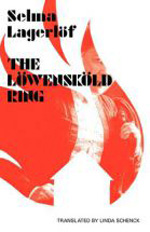

Norvik Press, paperback, 9781870041928
Translator Linda Schenck's notes to her 1991 English version of Selma Lagerlöf's The Löwensköld Ring are almost as interesting as the novella itself, and anyone interested in literary criticism might easily get sidetracked musing about theories of translation instead of focusing on the brilliance of this newly reissued edition of the first installment of Lagerlöf's Swedish ring cycle. Suffice it to say that Selma Lagerlöf would have appreciated Schenck's sensitivity to translation, since the author was a stickler for voice and style.
The Löwensköld Ring is, on its face, a ghost story told by a narrator, probably elderly, certainly female, whose "once upon a time" style is deceptively quaint. (More of this anon.) Briefly, General Bengt Löwensköld is given a ring by King Karl VII of Sweden for his valor in Sweden's various wars in Russia and Poland. Löwensköld insists on being buried with the ring, but it is stolen and changes hands several times, cursing whomever comes in contact with it.
The novella includes familiar elements of northern European folk tales—the simple farmer and his cagey wife, a dark forest, a beautiful maid, a hero king, and, of course, a magic ring. Shades of the Niebelungenlied, Lord of the Rings, and Scandinavian sagas and eddas.
But where folk tales use archetypes to clarify and strengthen social mores and norms—honesty, valor, courage, purity—Lagerlof twists these elements into something more ambiguous that explores the nature of guilt and innocence, of culpability and collusion, and the nature of justice. The simple farmer may actually be manipulating his cagey wife into criminal complicity. The beautiful maid, becomes, if not ugly, something of a witch. The hero-king Karl VII is also a tyrant who beggars his county with egomaniacal invasions. Ring has often been compared with Henry James's The Turn of the Screw, but is more like The Sybil, by Pär Lägerkvist, Lagerlöf's compatriot, which also takes on the revision of myth.
Like Lägerkvist's work, Lagerlöf's Ring makes liberal use of doppelgangers for most of the characters, so that the story seems to be told not once but several times through similar characters, adding more complexity each time. For instance, Marita, the beautiful maid who grows witchlike, is mirrored in Malvina, the pretty little housekeeper in love with her employer's handsome son. Both Marita and Malvina become custodians of the ring, and their lives seem to follow similar paths, but this is not as inevitable as it might seem. The simple rustic who steals the ring from the dead general is reflected in his own son, also a thief, and then in three humble farmers who end up paying for stealing the ring—which they may or may not have done.
The most fascinating questions to ponder in reading Lagerlof's novella are why the
author chose this kind of oblique storytelling through the grandmotherly narrator. One
answer might be that Grandma is a bridge between the old mores of the folktale and a
more modern and layered view of morality. Grandma is a reliable narrator but a foxy
one. Her narrative is punctuated with seemingly innocent commentary such as "well,
who wouldn't?" and "everyone thought"—the equivalent of our modern "I'm just
sayin'.…" Whatever those implicit questions mean, Grandma makes deep and interesting
company, and Lagerlöf is a writer who is well worth rediscovering.

Selma Lagerlöf was the 1909 recipient of the Nobel Prize for literature. A short biography of her can be read on the Nobel Prize website. The Löwensköld Ring was originally translated into English by Francesca Martin and published in 1928 under the title The General's Ring. Norvik Press has brought Linda Schenck's 1991 translation back into print with this new edition.
